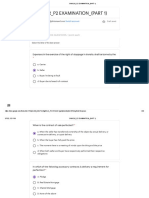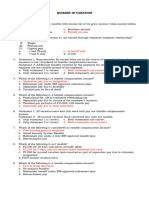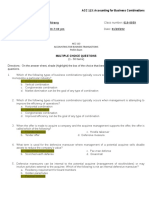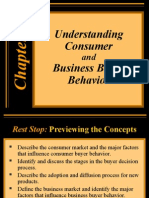Acc 112 TG#09
Acc 112 TG#09
Uploaded by
Carren joy MendozaCopyright:
Available Formats
Acc 112 TG#09
Acc 112 TG#09
Uploaded by
Carren joy MendozaOriginal Title
Copyright
Available Formats
Share this document
Did you find this document useful?
Is this content inappropriate?
Copyright:
Available Formats
Acc 112 TG#09
Acc 112 TG#09
Uploaded by
Carren joy MendozaCopyright:
Available Formats
ACC112: CORPORATE GOVERNANCE, BUSINESS ETHICS,
RISK MANAGEMENT AND INTERNAL CONTROL
Teachers’ Guide Module #09
Name: ____________________________________________________________ Class number: _______
Section: ____________ Schedule: _____________________________________ Date: _______________
Materials:
LEARNING OBJECTIVE: Student Activity Sheet;
This assessment measures the competence of the student in terms pencil with eraser and ball pen
of his/her application of knowledge and skills in the following topics:
1. Introduction to Corporate Governance
2. Corporate Governance Responsibilities and Accountabilities
3. SEC Code of Corporate Governance
4. Introduction to Ethics
5. Business Ethics
ACC 112 - CORPORATE GOVERNANCE, BUSINESS ETHICS, RISK MANAGEMENT AND INTERNAL CONTROL
FIRST PERIODIC EXAMINATION
GENERAL DIRECTIONS
READ THIS PAGE BEFORE STARTING THE ASSESSMENT
This test is composed of two (3) sections and has a total score of sixty fifty (60) points. You have one (1)
hour to finish this examination. The composition is as follows:
(1) Multiple-choice question Section. The questions in this section is with four answer choices. The test
is composed of thirty (30) questions and is rated as one (1) point each.
(2) Enumeration Section. The test is composed of three (2) problems with several
sub-problems/requirements. Please see rating per problem/requirement.
(3) Essay Section. The test is composed of two (2) problems with several sub-problems/requirements.
Please see rating per problem/requirement.
All things unnecessary for the test must be put in front of the testing area. Use BLACK or BLUE ink
ballpen only. Write all your answers on the designated space. Further, erasures are strictly NOT
allowed and will invalidate your answers.
You may NOT use smart phones or reference materials during the testing session. Only the allowed
calculators should be used.
Try to answer all questions. In general, if you have some knowledge about a question, it is better to
try to answer it. You will not be penalized for guessing.
Be sure to allocate your time carefully so you can complete the entire test within the exam session.
You may go back and review your answers at any time during the exam session.
Those who are caught cheating or doing acts not allowed during the exam shall be instructed to
surrender their test papers and shall leave the testing room immediately. Subsequently, their
papers shall be rated as ZERO.
This document is the property of PHINMA EDUCATION
ACC112: CORPORATE GOVERNANCE, BUSINESS ETHICS,
RISK MANAGEMENT AND INTERNAL CONTROL
Teachers’ Guide Module #09
Name: ____________________________________________________________ Class number: _______
Section: ____________ Schedule: _____________________________________ Date: _______________
This concludes the instruction page.
You may now begin answering.
MULTIPLE CHOICE
________1. The corporate governance structure of a company reflects the individual companies.
a. Cultural and economic system.
b. Social and regulatory system.
c. Legal and business system.
d. All of the above.
________2. The internal audit function is least effective when department:
a. Is objective.
b. Is non-independent.
c. Exhibits integrity.
d. Is objective
________3. An organization’s appropriate tone at the top promoting ethical conduct is an example of:
a. Ethics sensitivity.
b. Ethics Incentives.
c. Ethical behavior.
d. Business Ethics.
________4. The ultimate reason or purpose for why we make decisions in business firm is based on:
a. Values
b. Legal Ethics
c. Profit Motive
d. Golden Rule
________5. How do law and business ethics relate to each other?
a. Ethics is unrelated to the law because ethics answers only moral questions.
b. The law established what is ethical, as anything which is automatically ethical.
c. Law and business ethics serve as an interactive system, informing and assessing each other.
d. Ethics entirely determines what the law will be, as ethics is focused on finding one right answer to every question.
________6. Corporate governance is a form of ____________?
a. External regulations.
b. Government control.
c. Self-regulation.
d. Charitable action.
________7. Who are organizational stakeholders?
a. Customers.
This document is the property of PHINMA EDUCATION
ACC112: CORPORATE GOVERNANCE, BUSINESS ETHICS,
RISK MANAGEMENT AND INTERNAL CONTROL
Teachers’ Guide Module #09
Name: ____________________________________________________________ Class number: _______
Section: ____________ Schedule: _____________________________________ Date: _______________
b. Government.
c. Employees.
d. All of the above.
________8. Which of the following are would most effectively act as primary objective of a business
organization?
a. To make Profit.
b. To procure resources.
c. To communicate with shareholders.
d. All of the above.
________9. Sets out the purpose and general direction for the organization? .
a. Mission statement
b. Vision Statement
c. Profit Statement
d. None of the above
________10. What is Ethics to do with?
a. Business.
b. wider community.
c. Nothing.
d. Right and wrong.
________11. A combination of face-to-face classes and home-based learning.
a. Traditional Learning set-up
b. Flexible learning Set-up
c. Mixed Learning Set-up
d. Modern Learning Set-up.
________12. What is meant by separation of ownership and control?
a. That those who control the company should be separate to those who own it
b. That the law should seek to keep the owners and controllers of company apart in order to avoid an
over-concentration of power High pay will render the board less competent.
c. That the owners of companies have become separated from those who control companies.
d. That owners and controllers of companies should not act in concert to defeat resolutions.
________13. What is the main purpose of corporate governance?
a. To ensure that regulatory frameworks are adhered to
b. To separate ownership and management control of organisations
c. To separate ownership and management control of organisations and the requirement for
increased accountability to stakeholder groups.
This document is the property of PHINMA EDUCATION
ACC112: CORPORATE GOVERNANCE, BUSINESS ETHICS,
RISK MANAGEMENT AND INTERNAL CONTROL
Teachers’ Guide Module #09
Name: ____________________________________________________________ Class number: _______
Section: ____________ Schedule: _____________________________________ Date: _______________
d. To maximize shareholder value.
________14. Which of the following is the study and practice of decisions about what is good, or right?
a. Consequences
b. Morals
c. Law
d. Ethics
________15. Directors’ responsibilities are unlikely to include
a. a fiduciary duty
b. a duty to keep proper accounting records
c. a duty to propose high dividends for shareholders
d. a duty of care
________16. To be successful, business ethics training programs need to:
a. focus on personal opinions of employees
b. be limited to upper executives
c. promote the use of emotions in making tough ethical decisions
d. educate employees on formal ethical frameworks and model of ethical decision making
_______17. Who is responsible for ensuring the accuracy, timeliness of public reporting of financial and
other information for public companies?
a. Securities and Exchange Commission
b. Board of Accountancy
c. External Auditors
d. Shareholders
_______18. Providing oversight of the internal and external audit function and the process of preparing
annual financial statements as well as public reports on internal control are responsibility of:
a. Internal Auditors
b. Audit Committee of BOD
c. External Auditors
d. Management
_______19. Which of the following is not functions of External auditors?
a. Audit of public company financial statements
b. Other services such as tax or consulting
c. Reporting results and analyses to management and audit committees
d. Audit of nonpublic company financial statements
This document is the property of PHINMA EDUCATION
ACC112: CORPORATE GOVERNANCE, BUSINESS ETHICS,
RISK MANAGEMENT AND INTERNAL CONTROL
Teachers’ Guide Module #09
Name: ____________________________________________________________ Class number: _______
Section: ____________ Schedule: _____________________________________ Date: _______________
_______20. Understanding that his role is not to act as auditor or to act as member of the management is
among the specific activities of:
a. Non-executive directors
b. Executive Directors
c. Stockholders
d. Board of Directors
_______21. Ensures that all its members feel that they have stake in it and do not feel excluded from the
mainstream of society.
a. Rule of Law
b. Equity and Responsiveness
c. Participation
d. Rule of fairness
_______22. Transparency and full disclosure advocate the following except
a. Sound disclosure policies and practices
b. Meeting the information needs of investment communities
c. Solid foundations for management oversight.
d. None of the above.
_______23. The characteristic of good governance where fair legal framework are enforces impartially is
a. Rule of Law
b. Accountability
c. Equity
d. Participation
________24. The following are duties and responsibilities of Corporate Secretary except
a. Advises establishment of board committees and their terms of reference.
b. Safekeep and preserves the integrity of the minutes of meetings of the board and its committee
c. Assures availability of proper orientation for the first-time directors.
d. Attends all board meetings, except when justifiable causes.
_______25. Professional competence is a principle of
a. Ethics
b. Professional Ethics
c. Personal Ethics
d. Business Ethics
This document is the property of PHINMA EDUCATION
ACC112: CORPORATE GOVERNANCE, BUSINESS ETHICS,
RISK MANAGEMENT AND INTERNAL CONTROL
Teachers’ Guide Module #09
Name: ____________________________________________________________ Class number: _______
Section: ____________ Schedule: _____________________________________ Date: _______________
_______26. the system of stewardship and control to guide organizations in fulfilling their long-term
economic moral, legal and social obligations towards stakeholders.
a. Governance
b. Good governance
c. Corporate Governance
d. Good government
________27. group of executives given the authority by the BOD to implement the policies it has laid down in
the conduct of business of the corp.
a. Director
b. Management
c. auditor
d. regulatory board
________28. any individual, organization or society who can either affect or be effected by company’s
strategies, policies, business decisions.
a. shareholders
b. investors
c. stakeholders
d. community
________29. Which of the following encourage employee participation?
a. training and development
b. reward/compensation policies
c. health, safety and welfare
d. all of the above
_______30. Providing oversight over management activities in managing credit, market, liquidity,
operational, legal and other risk exposures of the corporation is the responsibility of:
a. Corporate Governance Committee
b. Board Risk Oversight Committee
c. Audit Committee
d. Related Party Transaction Committee
Part II. Enumeration (20 pts)
1. Enumerate the 16 Principle of SEC Code of Corporate Governance? (4 pts)
This document is the property of PHINMA EDUCATION
ACC112: CORPORATE GOVERNANCE, BUSINESS ETHICS,
RISK MANAGEMENT AND INTERNAL CONTROL
Teachers’ Guide Module #09
Name: ____________________________________________________________ Class number: _______
Section: ____________ Schedule: _____________________________________ Date: _______________
Answer:
1. Establishing a competent board.
2. Establishing Clear Roles and Responsibilities of the Board.
3. Establishing Board Committees
4. Fostering Commitment
5. Reinforcing Board Independence
6. Assessing Board Performance
7. Strengthening Board Ethics
8. Enhancing Company Disclosure Policies and Procedures
9. Strengthening the External Auditor’s Independence and Improving Audit Quality
10. Increasing Focus on Non-Financial and Sustainability
11. Promoting Comprehensive and Cost-Efficient access to relevant information
12. Strengthening the Internal Control System and Enterprise Risk Management Framework
13. Promoting Shareholder Rights
14. Respecting Rights of Stakeholders and effective redress for Violation of Stakeholder’s Rights
15. Encouraging Employee participation
16. Encouraging Sustainability and Social Responsibility
2. List down the objectives of corporate governance.
Answer:
The objectives of corporate governance are
1. To build an environment of trust and confidence among those who have competing and
conflicting interest.
2. To enhancing the shareholders’ value and protect the interest of other stakeholders.
3. To have system and procedure.
Part III. Essay (10 points each)
1. Explain the concept of comply and explain approach.
Suggested Answer:
Comply or Complain approach combines the voluntary compliance with mandatory disclosure.
Companies do have to comply with the code, but they must state in their annual corporate governance
reports whether they comply with the Code Provisions, identify any areas of non-compliance, and
explain the reasons for non-compliance
2. Briefly discuss the economic impact of failure to observe business ethics.
This document is the property of PHINMA EDUCATION
ACC112: CORPORATE GOVERNANCE, BUSINESS ETHICS,
RISK MANAGEMENT AND INTERNAL CONTROL
Teachers’ Guide Module #09
Name: ____________________________________________________________ Class number: _______
Section: ____________ Schedule: _____________________________________ Date: _______________
Suggested Answers:
Failure to observe laws and regulations by companies and employees may lead to legal charges.
Negative effect to employee’s performance.
Employer-employee relationship can be affected, lack of respect.
Damage to company credibility
-NOTHING FOLLOWS-
This document is the property of PHINMA EDUCATION
You might also like
- Preliminary ExaminationDocument30 pagesPreliminary Examinationfionachelsea.spNo ratings yet
- Goal The Ball Doesnt Go in by Chance Management Ideas From The World of Football (Soriano, Ferran)Document209 pagesGoal The Ball Doesnt Go in by Chance Management Ideas From The World of Football (Soriano, Ferran)brainNo ratings yet
- Method Statement For Installation of Chain Link Fence Rev 0Document11 pagesMethod Statement For Installation of Chain Link Fence Rev 0sathiyaprasath80% (10)
- BSBPMG531 - Assessment Task 1Document8 pagesBSBPMG531 - Assessment Task 1NghĩaHoàngTrầnNo ratings yet
- BUS 210 Module Six Assignment Template Text-Only VersionDocument2 pagesBUS 210 Module Six Assignment Template Text-Only VersionMariah J Baker0% (2)
- Acc 112 TG#8Document5 pagesAcc 112 TG#8Carren joy Mendoza100% (1)
- Review P3Document15 pagesReview P3Rona Amor Munda100% (1)
- ACC 112 - SAS #17 P2 ExamDocument10 pagesACC 112 - SAS #17 P2 ExamTrisha Marie BuendichoNo ratings yet
- Acc 112 Sas6Document8 pagesAcc 112 Sas6Maria Raven Joy ValmadridNo ratings yet
- ACC112 Lesson 2 AnswerDocument4 pagesACC112 Lesson 2 AnswerJohn Lorenz DayanghirangNo ratings yet
- ACC 139 Prelim ExamsDocument16 pagesACC 139 Prelim ExamsCarren joy MendozaNo ratings yet
- P1 Quiz FIN 073Document7 pagesP1 Quiz FIN 073Danica Mae Ubenia0% (1)
- Eco P3Document5 pagesEco P3John ManlapazNo ratings yet
- Exam Reviwer in GbermicDocument23 pagesExam Reviwer in GbermicMary Elisha PinedaNo ratings yet
- Notes in ACC148 P1docxDocument4 pagesNotes in ACC148 P1docxShaina Laila OlpindoNo ratings yet
- Psy 002 Merged CompleteDocument216 pagesPsy 002 Merged CompleteMaria Raven Joy ValmadridNo ratings yet
- ACC 143 Quiz 2Document9 pagesACC 143 Quiz 2Riezel PepitoNo ratings yet
- Fin 072 Cfe Sy2122 With AkDocument15 pagesFin 072 Cfe Sy2122 With Akbrmo.amatorio.uiNo ratings yet
- Acc148 ReviewerDocument7 pagesAcc148 ReviewerJessica FernandezNo ratings yet
- SHAREHOLDERSDocument6 pagesSHAREHOLDERSJoana MarieNo ratings yet
- Bam 242 - P2 Examination - (Part 1) : I. Multiple Choice Questions. 1 Point EachDocument20 pagesBam 242 - P2 Examination - (Part 1) : I. Multiple Choice Questions. 1 Point EachRosemarie VillanuevaNo ratings yet
- Management Science ExamDocument6 pagesManagement Science ExamJovito ReyesNo ratings yet
- FIN 072 - SAS - Day 17 - IN - Second Period ExamDocument12 pagesFIN 072 - SAS - Day 17 - IN - Second Period ExamEverly Mae ElondoNo ratings yet
- FIN 072 - SAS - Day 17 - IN - Second Period Exam OriginalDocument16 pagesFIN 072 - SAS - Day 17 - IN - Second Period Exam OriginalCharles AbulagNo ratings yet
- ACC 115 P3 Exam CFEDocument19 pagesACC 115 P3 Exam CFEsabit.michelle0903No ratings yet
- ACC 113 - SAS - Day - 2Document8 pagesACC 113 - SAS - Day - 2Joy QuitorianoNo ratings yet
- 3 - Quizzer On Gross Income (With Answers)Document19 pages3 - Quizzer On Gross Income (With Answers)Demon AlphaNo ratings yet
- Gin BilogDocument14 pagesGin BilogHans Pierre AlfonsoNo ratings yet
- Bam 241 Tos 1Document5 pagesBam 241 Tos 1Julian Adam PagalNo ratings yet
- Prelim With Answer Keys - Law PDFDocument2 pagesPrelim With Answer Keys - Law PDFKaren DammogNo ratings yet
- 1) Answer: Interest Expense 0 Solution:: Financial Statement AnalysisDocument3 pages1) Answer: Interest Expense 0 Solution:: Financial Statement AnalysisGA ZinNo ratings yet
- Cae15 Chap16 TheoriesDocument21 pagesCae15 Chap16 TheoriesJomarNo ratings yet
- Prelim ACC 113Document15 pagesPrelim ACC 113Ms VampireNo ratings yet
- SAS#7-BAM 062 (Edited)Document9 pagesSAS#7-BAM 062 (Edited)Rj ArenasNo ratings yet
- ACC 108 - Day 17 - SASDocument14 pagesACC 108 - Day 17 - SASEverly Mae ElondoNo ratings yet
- BAM 208 - SAS - Day 3 - OUTDocument10 pagesBAM 208 - SAS - Day 3 - OUTAriane Grace Hiteroza MargajayNo ratings yet
- TG2 Acc115Document12 pagesTG2 Acc115XieNo ratings yet
- CMPC131Document15 pagesCMPC131Nhel AlvaroNo ratings yet
- Mansci - Chapter 3Document2 pagesMansci - Chapter 3Rae WorksNo ratings yet
- SAS9 FIN081 1st Periodical ExamDocument17 pagesSAS9 FIN081 1st Periodical ExamIra CuñadoNo ratings yet
- SAS9 ACC115 1st Periodic ExamDocument3 pagesSAS9 ACC115 1st Periodic ExamElizabeth diane NOVENONo ratings yet
- Psy 002 Merged CompleteDocument216 pagesPsy 002 Merged CompleteMaria Raven Joy ValmadridNo ratings yet
- True/False: Chapter 6: Master Budget and Responsibility AccountingDocument45 pagesTrue/False: Chapter 6: Master Budget and Responsibility Accountingjomari legaspiNo ratings yet
- Quiz - Chapter 2 - Business Combinations (Part 2)Document4 pagesQuiz - Chapter 2 - Business Combinations (Part 2)Pearly Jean ApuradorNo ratings yet
- For MidtermDocument107 pagesFor MidtermAngelica RubiosNo ratings yet
- Eco QuizDocument5 pagesEco QuizSabbir HassanNo ratings yet
- CH 19 & 20 Practice QuestionsDocument2 pagesCH 19 & 20 Practice QuestionsNCTNo ratings yet
- Identify The Choice That Best Completes The Statement or Answers The QuestionDocument20 pagesIdentify The Choice That Best Completes The Statement or Answers The QuestionFebby Grace Villaceran Sabino0% (2)
- Accounting For LeaseDocument36 pagesAccounting For LeaseenajymiNo ratings yet
- Quiz No 1 PartnershipDocument3 pagesQuiz No 1 PartnershipClyden Jaile RamirezNo ratings yet
- IAS 33 - Mul Choice - SVDocument5 pagesIAS 33 - Mul Choice - SVTuan Huy Cao pcpNo ratings yet
- Chapter 1: PartnershipDocument121 pagesChapter 1: PartnershipGab IgnacioNo ratings yet
- Name: - Section: - Schedule: - Class Number: - DateDocument4 pagesName: - Section: - Schedule: - Class Number: - Datechristine_pineda_2No ratings yet
- Notes in ACC116 P1Document3 pagesNotes in ACC116 P1Shaina Laila OlpindoNo ratings yet
- Bam242 Cfe ReviewerDocument8 pagesBam242 Cfe ReviewerJanaisa BugayongNo ratings yet
- NOTES - GOVBUSMAN - Chapter 2Document3 pagesNOTES - GOVBUSMAN - Chapter 2Bundalian, Louisse Nicole A.No ratings yet
- ACC 139 SAS Day 17 EXAM JLDDocument20 pagesACC 139 SAS Day 17 EXAM JLDmarili ZarateNo ratings yet
- GenebraDocument13 pagesGenebraHans Pierre AlfonsoNo ratings yet
- Quiz - Understanding The Entity and Its EnvironmentDocument4 pagesQuiz - Understanding The Entity and Its EnvironmentKathleenNo ratings yet
- Test Bank Support DepartmentDocument15 pagesTest Bank Support DepartmentMarcella NataniaNo ratings yet
- Coc Revised Curriculum Bsma Sy 2018 2019 Duly NotedDocument6 pagesCoc Revised Curriculum Bsma Sy 2018 2019 Duly NotedJoseph Niño CuatonNo ratings yet
- AFAR Assessment 2Document5 pagesAFAR Assessment 2JoshelBuenaventuraNo ratings yet
- Acc 112 Q2Document4 pagesAcc 112 Q2Carren joy MendozaNo ratings yet
- This Document Is The Property of PHINMA EDUCATIONDocument4 pagesThis Document Is The Property of PHINMA EDUCATIONLexy Jill Teves BarrientosNo ratings yet
- Barista Coffee Company Limited: Indian Institute of Management Ahmedabad IIMA/MAR0387Document21 pagesBarista Coffee Company Limited: Indian Institute of Management Ahmedabad IIMA/MAR0387Anushka KuthariNo ratings yet
- Revised 1 EPCRFPDocument 180621Document65 pagesRevised 1 EPCRFPDocument 180621RupaliNo ratings yet
- Immediate Download Hotel Convention Sales Services and Operations 1st Edition Pat Golden-Romero Ebooks 2024Document84 pagesImmediate Download Hotel Convention Sales Services and Operations 1st Edition Pat Golden-Romero Ebooks 2024niyasafaneva100% (5)
- Innovative Pharmaceuticals Pvt. LTD.: Tax Invoice Date: 05-Jul-2022 - Invoice No.: 06704Document2 pagesInnovative Pharmaceuticals Pvt. LTD.: Tax Invoice Date: 05-Jul-2022 - Invoice No.: 06704aditya varmaNo ratings yet
- MGT702 Total Quality Management Seminar Presentation - UpdatedDocument23 pagesMGT702 Total Quality Management Seminar Presentation - UpdatedAlisha PrasadNo ratings yet
- Guidelines in The Audit of GAD Fund and Activities in Government Agencies (COA Circular 2014-01)Document55 pagesGuidelines in The Audit of GAD Fund and Activities in Government Agencies (COA Circular 2014-01)PSU PCOONo ratings yet
- Chapter 3. IT in Logistics and SCMDocument37 pagesChapter 3. IT in Logistics and SCMnhidoandkhNo ratings yet
- VAT Impact On Transportation and Logistics Sectors - 25 July 2023Document27 pagesVAT Impact On Transportation and Logistics Sectors - 25 July 2023marketingNo ratings yet
- MuguShop ProposalDocument7 pagesMuguShop ProposalMilan ChaudharyNo ratings yet
- Ap 95 PWDocument6 pagesAp 95 PWAnnaNo ratings yet
- Vietnam It Outsourcing CompanyDocument1 pageVietnam It Outsourcing Companyvietnam it outsourcing companyNo ratings yet
- Forklift Operator GurditDocument2 pagesForklift Operator GurditMandeep singhNo ratings yet
- Metal Fabrication Valu Chain Fain AlDocument41 pagesMetal Fabrication Valu Chain Fain AlElias Weldeyohans50% (2)
- Chapter 7 - MarketingDocument47 pagesChapter 7 - MarketingKidan AmareNo ratings yet
- Understanding Consumer and Business Buyer BehaviorDocument36 pagesUnderstanding Consumer and Business Buyer BehaviorAlrifai Ziad Ahmed100% (5)
- Sip Report FialDocument52 pagesSip Report FialTurkyaNo ratings yet
- Special Attachment Annual Income Tax Return For Corporate: ResetDocument3 pagesSpecial Attachment Annual Income Tax Return For Corporate: ResetMusi jayaNo ratings yet
- A Systematical Analysis Framework On LululemonDocument6 pagesA Systematical Analysis Framework On Lululemonmezitlabas profNo ratings yet
- Civil Law Review b22Document162 pagesCivil Law Review b22timothymaderazoNo ratings yet
- AGAETNCH Applications Annexure III of G O 321 With Check List 20200714122106Document12 pagesAGAETNCH Applications Annexure III of G O 321 With Check List 20200714122106Vinoth KumarNo ratings yet
- Recruitment Through AI in SelectedDocument9 pagesRecruitment Through AI in SelectedMihiraka alahakoonNo ratings yet
- PharmTech NA Aug2017Document68 pagesPharmTech NA Aug2017sridwiwulan dariNo ratings yet
- PEST Analysis of Engro Fertilizers, PakistanDocument5 pagesPEST Analysis of Engro Fertilizers, Pakistantalha botoNo ratings yet
- MARKETING MANAGEMENT Report Ice TeaDocument12 pagesMARKETING MANAGEMENT Report Ice TeaHamza SabirNo ratings yet
- INCOME TAX AND GST. JURAZ-Module 2Document5 pagesINCOME TAX AND GST. JURAZ-Module 2TERZO IncNo ratings yet
- Republic of The Philippines Department of Trade and Industry Business Name Registration Sole Proprietorship Application FormDocument5 pagesRepublic of The Philippines Department of Trade and Industry Business Name Registration Sole Proprietorship Application FormArlene LynNo ratings yet

























































































